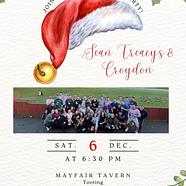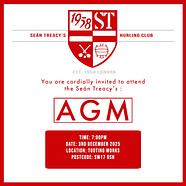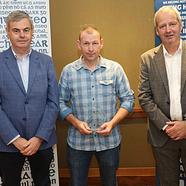Ahead of our annual Golf Classic, we would like to share Part 2 of the interview with the late Patrick Quinlan - Enjoy the read and best of luck tomorrow
Interview by Adrian Mulchinock and Donal Henley; transcribed by Ollie O'Donoghue
Watching the GAA
It was hard to get the Irish Post in London, and so Ambrose Gordon from Gabriels would bring videos of the Sunday Game and sell them to the pubs here, so the Sunday Game became the Monday Game here. That was in the '80s.
Everyone would go out to watch the games - Paddy remembers watching a Kerry game in Jack Beers pub in Tooting once and you could not move.
Star players
There were three great players in the 1960s and they all lived around Guildford. They would train amongst themselves near Guildford and travel up in a van for matches. They enjoyed a drink in the Wilton. Paddy remembered how a lot of the players worked in the building trade.
Danny Croke was full forward and from Mooncoin in Kilkenny. He won a Junior All-Ireland with London in 1963. Mick Butler was a back and also from Kilkenny and he won a Junior All-Ireland with Pakie Hourigan for London around the same time. Mick Cahill was a back and from Tipperary - he was the older of the three.
'Croke and Butler were great hurlers, they were with us for five years and were a great asset to their club,' said Paddy. 'Those three players made the Treacys team in my opinion. They were the link men, all strong men.'
In 1958, when the club was founded, they reached the final of the Junior League and Junior Championship. The Pearses beat them in the Championship and the match was played in November. They also played St Martins in Sutton around that time and they had a good hurling team.
Con McGrath reckons when the Cormacks joined the Treacys some time around the 70s, it saved the club. John brought six or seven more with him and they were all good hurlers, including his brother Skippy.
1984 was the first senior hurling title for Sean Treacys. It was an awful wet day for the final, and was played in the Wilton (sic). Although Ruislip had been opened, but it wasn't ready. There was no cup presented.
Committee meetings
Paddy was secretary of Sean Treacys in 1960 and 1961. He lived with Con McGrath and Pakie Hourigan on Marius Road in Balham and together they formed the club.
'We were all from the same area and had the same ideas,' said Paddy. 'It was all hurling.'
Paddy O'Brien was the first chairman. Frank Finnerty was the first treasurer. The Limerick City man Con Hegarty was also on the committee and was a great supporter, but he later went back to Ireland and set up a scrap metal business there. Christy Rainsford from Limerick was another great supporter. Tom Maunsell was another great supporter.
They always held a raffle each Christmas which was well received.
The Pearses and Brian Borus were the big teams in the early years, and then Sean Treacys rose up and won the Collins Cup. Paddy reckoned that the selectors was a particularly important role and team selection could have a huge impact on matches. There was always four or five selectors.
Dance Hall days
It used to be easy to sell tickets for a dance as we had so much support. The first dance was in Jim Flynn's Morris Hall in Wimbledon. They used to take place on a Thursday night. The deal was you sold the tickets and they would pay the money on the door, as the hall had to take their cut and to pay the band.
In 1960, Treacys held a dance at the Shamrock club in Elephant and Castle, close to the Tube station. It snowed and Bill Maunsell and Paddy Quinlan were left there on their own, and tried to get a reduction on the rent of the hall. They didn't make a penny on that dance. Conway was more supportive if a dance was not well attended.
Dancing was very popular back then. The Locarno in Streatham was open every night of the week, and later became the Cat's Whiskers Club.
Young Conway had a dance hall in Hammersmith, and the Clann na hEireann in which Quinlan was involved would have a ceili there on a Monday. They also had a dance on Tuesday, Thursday, Friday, Saturday and Sunday night. The Gresham in Camden Town was also popular. Nurses got in for free on a Monday so the dance that night was very popular. You could hardly get in there on a Monday.

A photo from a fundraising dance at the Arranmore dance hall in Balham in July 1960 shows the following people: Kitty and Jimmy Hourigan [Jimmy was full back and brother of Pakie Hourigan], Bill Maunsell, Dick Shandley ['a great man, he lived in North London and followed the Treacys everywhere'], Paddy Quinlan, Tom Bannon [from Athlone, a manager at the time], Tommy Gleeson from Kilkenny, Mick Madden and his son Tomas [they were over visiting at the time and were from where Paddy grew up], Sean O'Donnell [first secretary of Sean Treacys], Christy Rainsford, Danny Lonergan, Mick Maunsell behind Jack Mackey [referee], Martin Carberry, Con McGrath.
The Arranmore was owned by Jim Conway, chairman of the London County Board, and Paddy Crowe from the Ramble used to work there.
The Borus and Emeralds
Paddy remembered Mick Hurley was part and parcel of the Brian Borus set-up, as was Jack Crimmins from Limerick, and they both lived around Cricklewood. A lot of the Borus hurlers would have worked in the Smith clock factory in Cricklewood.

© Smiths Instruments / www.smiths-instruments.co.uk
Paddy also remembered the story of Timmy Donoghue, a cousin of Pakie Hourigan, who hurled in the 1955 Munster Minor Final in which he marked Liam Devaney. He was brought off at one stage and came back on to the field of play with his head bandaged. Paddy remembers the commentator Micheal O'Hehir saying that he played even better after that.
'He was fearless.' summed up Paddy.
One of the greatest hurling matches Paddy Quinlan watched was when Sean Treacys beat Gabriels in the 1962 Connors Cup final.
Emeralds were a separate club who trained in Clapham Common. The Emeralds were mostly made up of Limerick men. Paddy and his friends would also play on the Common, as they could go straight there on the bus.
'The Commons all had Rangers in them days', said Paddy. 'They wore a brown suit or hat and tried to stop us from hurling. We would sometimes play there until late or until the ranger would stop you. I suppose they were afraid someone would get hit by the ball, which was fair enough.The Rangers could even stop you cycling across the Common.'
There was room for a new club in south London - Paddy recalled how there could be up to 20 lads practicing by the old psychiatric hospital in Tooting Bec, and they were not attached to any club.
In 1962, there was 62 clubs affiliated to the London GAA. There was a hurling club and football club in Croydon called the Michaels. They were there before the Treacys. Croydon was full of Irish.
Sean O'Donnell suggested Tír na Nóg as the name for the club, but Pakie Hourigan said why don't we call it Sean Treacys, as he stayed at his house when he was younger. There was no objection to that.
Hopes for the future
'To me, the club has got a new lease of life,' said Paddy. 'For a club to function properly, you need a good strong back-up team, as I look at it now, and anybody looking in on it, I'm delighted because what I've seen the past couple of years - on the sideline and everything - is so united.
'I was only part of the club like anybody else, I want to see the club prosper and continue to grow.'
Link to interview Part 1
How an All-Ireland Clash brought President Paddy Quinlan to London







